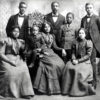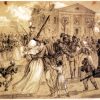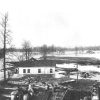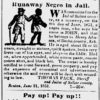calsfoundation@cals.org
112th United States Colored Infantry (US)
aka: Fifth Arkansas Volunteer Infantry (African Descent)
The 112th United States Colored Infantry was a United States Colored Troops (USCT) regiment formed in Arkansas during the Civil War. Consisting of former slaves, the unit was originally known as the Fifth Arkansas Volunteer Infantry (African Descent).
The arrival of Federal troops in the state in 1862 brought hundreds of former slaves into Union lines. After the Army of the Southwest took the Mississippi River port of Helena (Phillips County), thousands of slaves made their way to the city and to the protection of the Union forces. Taking advantage of this source of manpower, Federal authorities began to organize military units of freedmen in 1863. The First Arkansas Volunteer Infantry Regiment (African Descent) was formed in April 1863 in Helena. Other units soon followed, and after the fall of Little Rock (Pulaski County) to Union forces in September 1863, more units were formed in the city.
The Fifth Arkansas began recruiting in May 1864. Over the rest of the year, only about 400 men joined the unit—a number substantially lower than the required 1,000 needed to form a complete regiment. The commanding officer of the Fifth Arkansas—which was organized into four companies—was Lieutenant Colonel John G. Gustafson, who previously served in the Third Minnesota Infantry.
The Fifth Arkansas spent most of its time performing physical labor rather than drilling or completing other military duties. When it first began its service, it was not part of a larger brigade. Assigned to the First Division of the Seventh Corps, the regiment’s name was changed to the 112th United States Colored Infantry by August 31, 1864.
The entire term of service for the regiment was spent working on a variety of tasks in Little Rock. Part of the regiment participated in one skirmish near Hickory Station when a train was derailed by Confederate forces. On February 1, 1865, the 112th joined the second brigade of the First Division. This brigade consisted of six USCT units. The 112th never recruited enough men to become a full-strength regiment but did gain an additional company to bring its total to five companies. In order to better manage the unit, the 112th consolidated with the 113th United States Colored Infantry and the Eleventh United States Colored Infantry on April 1, 1865. This regiment was known as 113th USCT (New), and it continued to serve in the Little Rock area until it was disbanded on April 9, 1866.
For additional information:
Gladstone, William. United States Colored Troops, 1863–1867. Gettysburg, PA: Thomas Publications, 1990.
Longacre, Edward G. “Letters from Little Rock of Captain James M. Bowler, 112th United States Colored Troops.” Arkansas Historical Quarterly 40 (Autumn 1981): 235–248.
David Sesser
Henderson State University
 113th United States Colored Infantry (US)
113th United States Colored Infantry (US) African Americans
African Americans Black Union Troops
Black Union Troops Civil War through Reconstruction, 1861 through 1874
Civil War through Reconstruction, 1861 through 1874 First Arkansas Volunteer Infantry Regiment (African Descent) (US)
First Arkansas Volunteer Infantry Regiment (African Descent) (US) Little Rock (Pulaski County)
Little Rock (Pulaski County) Military
Military Mississippi River
Mississippi River Slavery
Slavery ACWSC Logo
ACWSC Logo 




My great-great-grandfather was the captain who was in the skirmish at Hickory Station, and I recently discovered a report from him describing it, which is exciting. Richard Curtis Custard was his name.